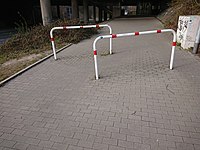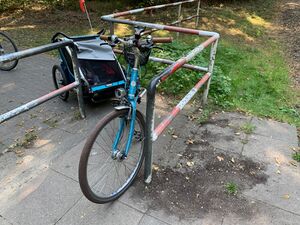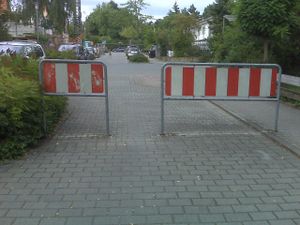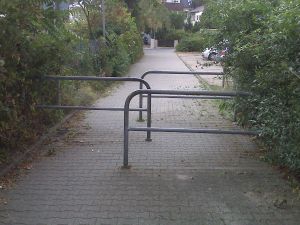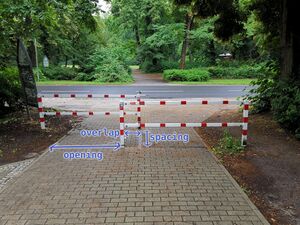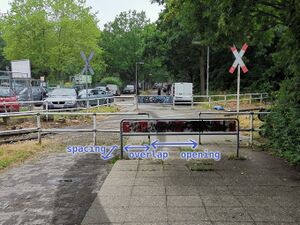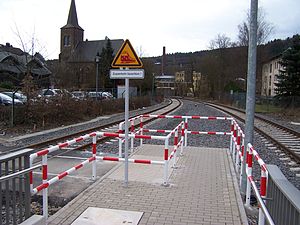Tag:barrier=cycle_barrier
| Description |
|---|
| A barrier along a path that slows or prevents access for bicycle users. |
| Rendering in OSM Carto |
| Group: barriers |
| Used on these elements |
| Useful combination |
|
| Status: approved |
| Tools for this tag |
|
Cycle barriers (or pedestrian chicanes) are fence-like barriers positioned along paths, footways, cycleways or tracks which serve to either slow cycle access or prevent it entirely depending on spacing and layout. Often made of steel, and laid out in a staggered chicane layout. The intent may also be to discourage motor vehicle access to the protected way: motorcycles and mopeds specifically.
How to map
Place a ![]() node that's part of the
node that's part of the ![]() way or track at the location of the barrier. Tag it with barrier=cycle_barrier.
way or track at the location of the barrier. Tag it with barrier=cycle_barrier.
You should also add further tags to more fully specify what kind of cycle barrier it is or what kind of traffic can pass the barrier. Depending on how much effort you can invest, there are these options to capture more information:
- Easy: Access to standard bicycles (bicycle=*) – see this section.
- Easy: Design of the barrier (cycle_barrier=*) – see this section.
- Advanced – simple dimension attributes: Maximum passage width on simple designs (maxwidth:physical=*) or the spacing=* of the grid elements on chicane designs – see this section.
- Advanced – complex dimension attributes: You can specify the exact dimensions of chicane designed cycle barriers with spacing=*, opening=* and overlap=* – see this section.
Access for bicycles and other vehicles
Standard bicycle access
This general form of barrier can be very variable in the sorts of traffic they allow to pass, and the greatest variability applies to bicycle traffic most of all.
For standard bicycles, it's a very good idea to add one of
- bicycle=no - "a normal bicycle will not physically fit (without dismantling it or lifting it over the barrier)"
- bicycle=dismount - "barrier prevents users of normal bicycles from riding through, but you can push a bike through"
- bicycle=yes - "barrier is easily passable mounted on a normal bike, even if you have to slow down"
If it's a question of degree of rider skill, put yourself in the shoes of an unskilled novice rider.
Footpath ways marked "no cycling" which have barriers of this sort should additionally be tagged bicycle=no on the way itself.
Passableness for cargo bikes, trailers, wheelchairs, etc.
Cycle barriers can be a significant obstacle for cyclists, especially with trailers or cargo bikes, but also for people in wheelchairs or pushing a stroller – or even make a path completely impassable for such user groups, even if e.g. cycling on a path is actually permitted. Whether such barriers are passable by a vehicle with certain dimensions (width, length) depends on the distances and passage widths of the grids/bars of the barrier. Because of the wide variety of different cargo bikes, bicycles, trailers or even wheelchairs, access tags such as bicycle=*, wheelchair=* or cargo_bike=* may not be sufficient.
However, determining the passableness of such barriers for a vehicle is much more complicated than for other barriers such as bollards or gates, since – depending on the type or design of a cycle barrier – specifying a maximum width is usually not sufficient. Rather, several geometric types, distances and dimensions have to be taken into account.
The following dimensions can be used to indicate the proportions of a bicycle barrier very precisely, from which the passableness for vehicles can be derived according to their size (for details on how to determine the passableness, see the proposal on advanced tagging of cycle barriers#Determine passableness). Which of these dimensions are necessary depends on the type/design of the barrier (see the table in the following section).
| Dimensions/size tags | Sufficient for which designs? (see table below) | Schematic illustration |
|---|---|---|
| maxwidth:physical=* for the maximum passage width | simple designs like single, tilted or diagonal |
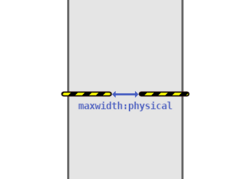
|
chicane designs like double and triple |
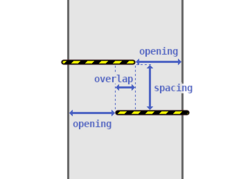
|
If a cycle barrier is obviously too narrow for bicycles, cargo bikes or wheelchairs, and you can't/don't want to measure the exact dimensions, bicycle=no, cargo_bike=no or wheelchair=no can also be tagged – but in general, access tags on barriers should be avoided if they can be derived more accurately from other attributes.
If there is a possibility to bypass the cycle barrier – e.g. via an informal path at the side – consider mapping this path separately with its properties and access information.
Access for motor vehicles
Assume that this kind of barrier implies motor_vehicle=no. If a cycle barrier can be opened or removed for vehicles such as emergency or winter services, use cycle_barrier:installation=* for this.
Types / designs of cycle barriers
The key cycle_barrier=* can be used to distinguish the basic construction forms of cycle barriers – each with certain effects on their passableness or the dimensions and distances necessary to determine the passableness. It's a textual expression for typical, commonly found construction designs:
| cycle_barrier=* | Picture | Schematic illustration | Description |
|---|---|---|---|
| single | 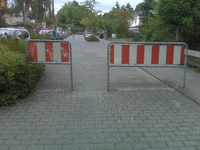 |
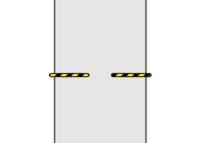 |
A barrier across the path with a passage where you don't have to go around a chicane. maxwidth:physical=* is usually sufficient to specify the passage width. |
| double |  |
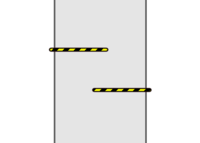 |
A chicane barrier across the path formed by two barriers/bars one behind the other. The dimensions of the barrier can be specified more precisely with spacing=*, opening=* and overlap=*. |
| triple | 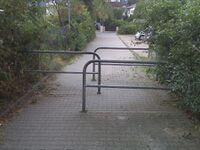 |
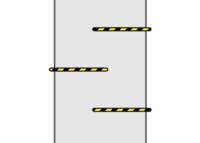 |
A barrier across the path shaped as a multiple chicane, usually formed by three barriers/bars in a row. The dimensions of the barrier can be specified more precisely with spacing=*, opening=* and overlap=*. |
| diagonal |  |
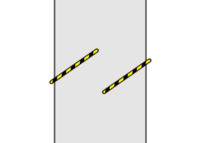 |
Barrier whose bars/elements are arranged at an angle and can - depending on the spacing of the bars/elements - therefore often be passed more easily and with less loss of speed, e.g. with bicycles. maxwidth:physical=* is usually sufficient to specify the passage width. |
| tilted | 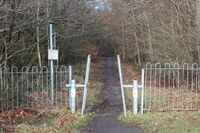 |
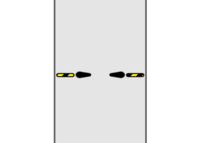 |
Tilted vertically arranged barrier elements that allow a rather narrow passage. Defining feature is a tilted barrier. Typically narrower than single, and greater barrier but it is possible that very narrow single will block passage in the same way[1]. Called "A-frame"[2] or "K-frame"[3] Originally used squeeze[4]
Similar to barrier=motorcycle_barrier |
Installation types of cycle barriers
Use cycle_barrier:installation=* to indicate whether a cycle barrier is fixed to the ground or can be opened, removed or similar (to allow the passage of e.g. emergency services or winter road maintenance – similar to bollards (bollard=*). The pictures below show examples for common mechanisms.
Note that usually a key is needed to open or remove a barrier of this kind.
| cycle_barrier:installation=* | Example picture | Description |
|---|---|---|
| fixed | 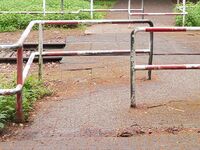 |
Barrier with bars/poles fixed to the ground (often set in concrete) so that the barrier can't be removed or opened. |
| openable | 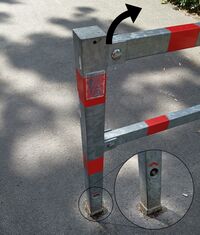 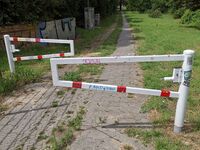 |
Barrier can be opened – a common mechanism are hinged bars that can be folded upwards or mechanisms like on swing gates. |
| removable | 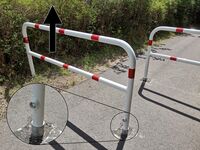 |
Barrier can be removed. In the case shown in the photo, the barrier can be lifted out of its mounting (as known from bollards). |
| foldable | ? | Barrier can be folded down with a hinge at its base. |
Examples
Despite the name, this kind of barrier can be very variable in shape and what kinds of traffic it stops or slows down, so it's a good idea to always add dimension or access tags.
Using access tags
|
|
Using dimension attributes
Note: Sometimes, you can "count" width values if you know the exact size of typical paving stones that are used in your local area. The paving stones in the first and last picture, for example, are 10×20 cm in size – with this knowledge you can easily "measure" the distances.
(OSM) |
(OSM) |
(OSM) |
Note: As this type of barrier only differs in the angle of entry from "normal" cycle barriers of the type "triple", it is not necessary to define a special type – simply "triple" can be used. corners=* provides more detailed information on the geometry of the driving line. |
Editors
- MapComplete supports this schema in its Bicycle infrastructure theme (Example).
- StreetComplete has shipped a quest to determine the type since v38.0.
See also
- cycle_barrier=* - Classification of types / designs of cycle barriers
- cycle_barrier:installation=* - Indicates whether a cycle barrier is fixed or can be opened, removed or similar
- spacing=* - Minimum distance between the grids of chicane shaped barriers like cycle barriers
- opening=* - Minimum opening or entrance/exit distance on chicane shaped barriers like cycle barriers
- overlap=* - Overlap distance of the barrier elements on multi-stage/chicane shaped barriers like cycle barriers
- corners=* - Corners that – geometrically speaking – must be driven when passing through a barrier
- barrier=barrier_board - Type of barrier to restrict the passage of a way or to block off an area (in general, not specifically for bicycles)
- bicycle=* - Access permission for cyclists
- wheelchair=* - Indicate if a special place can be used with wheelchairs
References
- ↑ https://wiki.openstreetmap.org/wiki/Talk:Proposed_features/Advanced_cycle_barrier_tagging#single_vs_squeeze
- ↑ http://www.kbarriers.co.uk/a-frame-barrier/ https://www.cycling-embassy.org.uk/dictionary/access-barrier
- ↑ https://www.cycling-embassy.org.uk/dictionary/access-barrier http://www.kbarriers.co.uk/barrier-type/
- ↑ https://wiki.openstreetmap.org/wiki/Proposed_features/Advanced_cycle_barrier_tagging https://lists.openstreetmap.org/pipermail/tagging/2021-October/062675.html https://wiki.openstreetmap.org/wiki/Talk:Proposed_features/Advanced_cycle_barrier_tagging#single_vs_squeeze
